EISEN,KEISAI (10 Ergebnisse)
Produktart
- Alle Produktarten
- Bücher (9)
- Magazine & Zeitschriften
- Comics
- Noten
- Kunst, Grafik & Poster (1)
- Fotografien
- Karten
-
Manuskripte &
Papierantiquitäten
Zustand
- Alle
- Neu
- Antiquarisch/Gebraucht
Einband
- alle Einbände
- Hardcover
- Softcover (1)
Weitere Eigenschaften
- Erstausgabe
- Signiert
- Schutzumschlag
- Angebotsfoto (9)
Land des Verkäufers
Verkäuferbewertung
-
[Tokyo, n.d. ca 1920's]. Color woodblock print, Aizuri-ban, sheet size: 37.4 x 25.7; print size:35 x 31.5 cm., pristine impression, registry, superbly clean, UNUSED example, seldom found. * * RARE EXAMPLE * * . *** **** *** . . WINTERY RIVER FERRY CROSSING . . .AN IMPRESSIVE VIEW OF A BITTER-COLD WINTER AFTERNOON . . . PASSENGERS & BOATMEN BUNDLE UP AGAINST THE FREEZING COLD . . * This is a lovely winter scene with lots of snow and people bundled up. It shows a "Watashi Bune," a small ferry boat for people to cross the XX river. . The two boatman wears a rice straw 'rain-coat' to shed the snow off of him and a bamboo hat. Passengers include an two old men without head covers, four women with face protecting cloths, and another peasant man also wearing a straw-rain. . The scene shows a black sky, gradiation into grey, with river in pale blue also gradiation into a dark & cold deep blue indigo. The snow covered trees, straw roofs, and other small boatmen are hunkered down all wearing straw rain coats, a very drab and "cold" wintery scene. . This is an "Aizuri-ban" or a print that uses aniline-blue color. . The colors effectively give the viewer a 'chill' when observing. . *** EISEN 1970-1848: He was an Ukiyo-e painter, print artist, print artist. The first pupil of Kano school artist Hakkeisai & Eizan. Best known for his stunning landscapes and collaboration with Hiroshige. See Lane below. . *** Color photos are posted to our website. . *** CONDITION: . This print is flawless, with superb impression and registry. This is an UNUSED example, the back side is also very clean, no issues. About as good as it can get. Ready for framing and display. . *** REFERENCE: LANE, Richard.: IMAGES FROM THE FLOATING WORLD: THE JAPANESE PRINT INCLUDING AN ILLUSTRATED DICTIONARY OF UKIYO-E, see p.219 for Eisen. . * .
-
[Tokyo ca 1920's,Takamizawa].Color woodblock print,excellent example, superb registry & impression, sheet size:37.5 x 25. 7 cm.; print size:35.6 x 23.5 cm.,there are 2 small mends to the back side, now firm & stable. with Dutch letter border. . *** **** *** . . A STUNNING CLASSIC VIEW OF MT. FUJI FROM THE CENTER . . . OF EDO AT NIHON-BASHI . . . WITH BORDER SHOWING FOREIGN LETTERS & SYMBOLS . . * This work was greatly influenced by the Dutch in Deshima, Nagasaki, who brought foreign letter texts to Japan. . Eisen was aware of the new words and alphabetical characters used by the Dutch. These new characters became the border of this print, with the word "HOLLAND" found at the upper right corner of the print. Though some letters are backwards, nevertheless they are impressive to the average Japanese who had never seen such 'symbols.' . This is an "aizuri-ban" or a print that uses aniline-blue color. . The colors effectively give the viewer a 'chill' when observing. . *** EISEN 1970-1848: He was an Ukiyo-e painter, print artist, print artist. The first pupil of Kano school artist Hakkeisai & Eizan. Best known for his stunning landscapes and collaboration with Hiroshige. See Lane below. . *** RARE EXAMPLE: This print has been coveted by collectors for the last 200 years ! Japanese prints with foreign alphabets are sparse and seldom found. On the verso is a small Hanko [stamp] by the famous Tokyo publisher/printer; "TAKAMIZAWA." . *** The classic scene of Nihon-bashi in the foreground with a stunning Mt. Fuji in the background touches every Japanese heart, the nostalgia of old Edo, showing the center of that ancient city. . It was from the Nihon-bashi, that the TOKAIDO GO-JU-SAN TSUG [FIFTY-THREE STAGES OF THE TOKAIDO] highway began as station one. . The print has a title caption and artist signature [all in block] at the upper left corner. On the lower edge are two Kanji, reading: GEN HAN" [ORIGINAL PRINTING]. . *** The work is strong in indigo-blue sky, gradating into pale 'sky-blue,' and the river blue. Fuji is depicted with lots of snow & ice in white on grey. The lands below Fuji are black over grey mountains, green forests, then the sprawl of Edo, castles, houses, to the Nihon-bashi river which flows under that iconic landmark bridge. . *** CONDITION: This is an excellent example with superb registry & impression, verso blank. On the verso [back side] there are two small remnants of a paper hinge on the top edge, there are two tiny left corner mends from the back side, these can be matted out. Else a truly superb example. Fresh, brilliantly clean and bright. . Ready for framing and display, an impressive compositing and perspective. . *** REFERENCE: . LANE, Richard.: IMAGES FROM THE FLOATING WORLD: THE JAPANESE PRINT INCLUDING AN ILLUSTRATED DICTIONARY OF UKIYO-E, see p.219 for Eisen. , *.
-
[Weapon, Education] Samurai and martial arts, published ca. 1850
Anbieter: Antiquariaat Arine van der Steur / ILAB, Den Haag, Niederlande
Booklet with text and images referring to samurai and their preparation to perform with various weapons.Some of the prints are handcolored. In the first part of the booklet is what looks like an open air gym with men and women fighting or resting.Woodcuts on paper, in original binding; double cover: the most external is rather damaged and it bears handwritten inscriptions; the internal cover is in rather thick paper, with embossed decoration.Despite the outer covers are in quite rough condition, the inside preserves all its fascinating allure.Japan - wapens - japans dun papier - schermen - pijl en boog - relief print met bloemen op eindpapier - gekleurd Keisai Eisen was een Japanse ukiyo-e kunstenaar die gespecialiseerd was in bijin-ga. Zijn beste werken, waaronder zijn ?kubi-e, worden beschouwd als meesterwerken uit het "decadente" Bunsei-tijdperk. Hij stond ook bekend als Ikeda Eisen en schreef onder de naam Ippitsuan.
-
TWO COLOR WOODBLOCK PRINTED SHUNGA [EROTIC] SHEETS.
Anbieter: RARE ORIENTAL BOOK CO., ABAA, ILAB, Aptos, CA, USA
[Japan ca 1830's, n.p.]. Two odd sheets from an unknown Shunbon [erotic book], woodblock printed in color, sold as a pair, unsigned as usual, old marginal thumbing, a bit dusty, else clean and solid work, nicely executed, unknown title. . . *** *** *** . . EROTIC WOODBLOCK PRINTS . . * KEISEN EISEN [1790-1848]: As usual Japanese works we most always unsigned. Attribution is done by artistic and stylistic comparisons to artist's work. In this case, the style is easily recognized to be Eisen's work. The typical long nose lines was one of his trademarks. . *** THE TITLE: The title is "Tama" a common name for a girl or cat in the mid-19th century. This is printed on the smaller print in the left gutter. We read that as "TAMA MAKI NO FUTATSU:" "TAMA SCROLL 2." . *** THE TWO SHEETS: Sheet 1: This shows a scene of two women, one grabs from behind in an effort to pull open the other woman's Kimono. . A man voyeur hidden in the bushes outside watches with much interest. On the floor is a folded group of "Chirishi" or typical Japanese hand-made Washi toilet paper and another stray sheet near by. . "Chirishi" is symbolic and associated with love-making and any other erotic practice. It is often illustrated in brothels or Shunga [erotic prints & books] with a meaning that love-making fluids would flow from either the vagina or ejaculation and this kind of "Chirishi" [tissue] was an essential part of love-making and its aftermath. . Just the image of "Chirishi" during the Tokugawa period was enough to excite both men and women ! . The illustrating of this in the room with these two women indicate they are ready and willing prostitutes. One is lonely and probably in love with the other girl. Lesbianism was a common feature in whore houses and among the prostitutes who found "true love" among their peers rather than with their male clients. Male clients came and went, and by and large seldom did a wealthy client buy out prostitutes and make them a wife. . Here we see one girl overtaken with jealousy or love for her co-worker. Prostitutes commonly carried substantial amounts of "Chirishi" in their Kimono sleeve for use before and after love-making. . This sheet is actually two pages co-joined in the center to make one larger page. With generous margins at the top and bottom, sheet size: 26.5 x 25.5, print size ca. 25.5 x 18.5 cm. In the lower left corner it is a bit "thumbed," else a clean and solid copy. . With a cartouche in the upper left corner with Japanese text reading "Sekikon kyuri wo zukuki kaigen" we shall not translate due to the erotic nature of this comment, suffice to say it expresses one girls need to "possess" her fellow prostitute and romantic companion! . *** SHEET 2: This shows a man and a woman on a verandah, she mounts and faces him, openly kissing. A small but critical point: notice her exposed right foot. While embracing her lover, the toes on her foot are curled tightly, indicating erotic sensuality, pleasure and orgasm. She also lock-embraces him tightly with both arms, indicates they are enjoying making love to the fullest. . There is a wad of rolled up "Chirishi" toilet paper adjacent to them, indicating preparedness for wiping up the love juices when finished. She is a well-prepared prostitute from the Ukiyo ["Floating" or "Fleeting World"]. . Above them is a fan-shaped cartouche which reads: "Shunraku tei ha zaishu utahime ni aku fu." again an erotic reference so the "Pleasures of spring [Shun, as in "Shun-ga" or "Erotic Spring Pictures" [pictures of love-making] and "aku fu" or "nasty habits" from the pleasures of "Spring erotica and love-making." . SHEET SIZE: This sheet is 17.5 x 25.3 cm., the print size is 13 x 19 cm., and there is a book title or at least an abbreviated title in the left margin reading: "Tama Maki no ni:" Tama [a girl's name] volume or scroll number 2]. This is also thumbed in the lower left corner, and has the stab marks of a sheet formerly bound into a book. . *** These two prints are odd pages from what appears to be a superbly drawn and executed period "Shunpon" [erotic illustrated book]. . Beautifully drawn by [Eisen], a very skilled master artist. Printed in typical pastel and vegetal colors with great taste. . *** KEISAI EISEN [1790-1848]: He was a Japanese Ukiyo-e artist who specialized in Bijin-ga [pictures of beautiful women]. His best works, including his Okubi-e ["large head pictures"], are considered to be masterpieces of the "decadent" Bunsei Era [1818-1830]). He was also known by his 'studio' name: Ikeda Eisen, among many others and also wrote under the name of Ippitsuan. . In addition to producing a prolific number of prints, he was a writer, producing biographies of the Forty-seven Ronin and several books, including a continuation of the Ukiyo-e Ruiko [History of Prints of the Floating World], a book which documented the lives of the Ukiyo-e artists. . His supplement is known as "Notes of a Nameless Old Man." He describes himself as a dissolute hard-drinker and claims to have been the owner of a brothel in Nezu in the 1830s which had burned down. Surely he was inspired by living his life among prostitutes and drew them often. This book is an excellent example from his life-style as an artistic whore house voyeur ! . *** REFERENCES: . L. Roberts: DICTIONARY OF JAPANESE ARTISTS, see p.21 for more details on Eisen, he specialized in Bijin Ga [pictures of beauties], erotica and landscapes. * WikiPedia: : SHIBUI, Kiyoshi.: ESTAMPS EROTIQUES PRIMITIVES DU JAPON:GENROKU KOHANAGA SHU-E . It is not surprising this and a plethora of other Japanese Shunga, Shunpon [Erotic prints & books] are not listed in Shibui. While he lists many, there are even more not listed in his book, or any other reference book on the subject. . Erotic books were "suppressed" by the Tokugawa Shogunate, therefore the majority of these kinds of books & prints were published on the 'black market' and not distributed openly. They remain on the 'fringe' of publication. There.
-
Edo Nihonbashi yori Fuji o miru zu]. [A View of Mt. Fuji from Nihonbashi].
Verlag: (Circa1930)., [Japan]., 1930
Anbieter: Asia Bookroom ANZAAB/ILAB, Canberra, ACT, Australien
Reprint. Color woodblock print, 25.5 x 37.7cm on sheet size 32 x 47cm, tipped in at upper edge to original paper mat. Short tears to paper mat. Very good condition. This captivating artwork presents a picturesque view of Tokyo with the iconic Mt. Fuji gracing the distant horizon. Keisai Eisen (1790-1848), a pupil of Kikugawa Eizan, was a prolific artist known for his diverse subjects, including "bijin" (beautiful women), shunga prints (erotic prints), and landscapes. Notably, he collaborated with Hiroshige on a landscape series, with Hiroshige completing the series when Eisen had a dispute with the publisher. An interesting detail is the use of alphabet characters as graphic symbols for framing the print, adding a unique and distinctive touch to the composition.
-
BUYU SAKIGAKE ZUE: ILLUSTRATIONS OF MILITARY COURAGE.
Anbieter: RARE ORIENTAL BOOK CO., ABAA, ILAB, Aptos, CA, USA
[Nagoya 1844-47?, Eirakuya]. Stiff orange wrs., stitched,16 x 23 cm., very good, usual minor edge wear, bit old worming only in the upper margin to 8p., else strong clear images, [20] double-folded leaves, 40 full page illustrations. Eisen was known for his stunning portrayal of Samurai warriors and traditional heroes. Like Kuniyoshi he excelled at action and sword play. This work continues in that vein with famous warriors subduing wild animals and challenging the most powerful sword fighters. A dramatic work, loaded with dynamic Samurai sword play and action ! **** THE WORK IN BIBLIOGAPHICAL TERMS: Kerlen states vol.1, vol.2 as the complete set; our copy clearly states "Zen" or "Complete" on the title slip, which appears to be 2 vols. bound in one. Kerlen states the complete set consists of 20 unnumbered pages. If it were incomplete, or an odd volume, the title slip would say vol. 1, or vol. 2, per Kerlen; as is. FIRST EDITION. **** REFERENCES: H. Kerlen: CATALOGUE OF PRE-MEIJI JAPANESE BOOKS AND MAPS IN PUBLIC COLLECTIONS IN THE NETHERLANDS #116, p.48-49. * KSM: KAIGA [Eiga]7-139-3 * Forrer:156-157 * Kraft: vol. 2, no. 40 * L. Roberts: DICTIONARY OF JAPANESE ARTISTS, p.21. ***.
-
[Edo? ca 1806-12, Tsuta Ya. Oban color woodblock print,sheet size: 24 x 36.3 cm., excellent impression & registry, pastel colors, two old folds, a couple of verso mends else clean & solid, no. 14 Hara No Eki Series. FIRST & ONLY RARE EDITION . *** **** *** . . A STUNNING PORTRAIT OF A JAPANESE WOMAN PILGRIM . . . SHE POSES BEFORE A GRAND MT. FUJI . . .WITH THE TOKAIDO HIGHWAY BACKGROUND & PALANQUIN COOLIES . . . FROM THE SUPERBLY EXECUTED SERIES: . . . HARA NO EKI JUYON BAN BIJIN TOKAIDO: HARA STATION, . . . NUMBER 14 OF THE BEAUTIES OF THE TOKAIDO SERIES . * This is a lovely view of a Japanese woman pilgrim on the highway, taking a break, as she wrings-out the water from her cotton Kimono, she holds a towel in her mouth. She glances at an right facing angle displaying a nice profile to her face. . *** THE ARTIST: EISEN [1790-1848]: He was an Ukiyo-E painter, printmaker, illustrator and the son of calligrapher Shigeharu, He lived in Edo, was a pupil of the Kano artist Hakkesai, then of the Ukiyo-e artist Kikugawa Eizan. His true name was IKEDA Yoshinobu before he took his master's name of Eisen. . He authored many illustrated books, was a prolific artist, specialized in Bijin Ga [pictures of beautiful women], erotica and landscapes. He also collaborated with Hiroshige on landscapes, doing the Kisoh Kaido [Sixty-nine stations of the Kisoh Highway]. . He used several Go [studio names]: Hokugoh, Hokutei, Ippitsuan, Kakoh, Keisai, Kokushunroh & Mumeioh. . He is well collected by world museums & libraries. See Roberts below. . *** CONDITION: The print has e excellent impression & registry, with bold & solid colors most in pastels. . The print has two mild old folds, there are two small, old restoration to the upper left & right corners with a couple old very minor mends all to the verso [back side] of the print. It is now solid and stable. . The surface is a bit dusty as usual, for an item over 210 years old. . *** NOTE: Color scans are posted to our website. . *** REFERENCES: . ROBERTS, Laurance P.: A DICTIONARY OF JAPANESE ARTISTS: PAINTING, SCULPTURE, CERAMICS, PRINTS, LACQUER, p.21. * LANE, Richard. : IMAGES FROM THE FLOATING WORLD: THE JAPANESE PRINT INCLUDING AN ILLUSTRATED DICTIONARY OF UKIYO-E, p. 219+ illustration examples. *.
-
Soft cover. Zustand: Very good. Keisai, Eisen (illustrator). A book of Japanese family crests and how to design them, beautifully woodblock printed. lncludes stunning prints of plants, animals, and landscapes (1 illustration of a flower lightly coloured by an ex-owner) as well, by famous Japanese artist Keisai Eisen (1790_1848). 30 l. Original binding and title plate. Wear, chipping and stains to covers, as to be expected. Minor occasional wormholing. Wear and some stains to contents. Has undergone some minor repairs. A little thumbing. Otherwise in fairly nice condition. Text in Japanese. Japanese fukurotoji binding. Used book.
-
Kamon amano ukihashi. Edo period 1830-44 (Tenpô).
Verlag: Edo period 1830-44 (Tenpô)., 1830
Anbieter: Antiquariat Stefan Wulf, Berlin, Deutschland
Kohon (18 x 12 cm). Blockbuchbindung mit schmucklosen Deckeln (stark knickspurig und berieben, aber Bindung völlig intakt). 29 Bll., mit 26 teils doppelblattgroßen - bis auf eine auch farbigen - Holzschnittillustrationen. Ein Holzschnitt als Frontispiz auf vorderem Innendeckel montiert (vermutlich so erschienen). Teils auf sehr dünnem und fragilem Papier gedruckt. Das Innenleben trotz offensichtlich häufigerer Konsultation des Büchleins bis auf stellenweise deutlichere Fingerflecken in den unteren, äußeren Ecken sehr gut erhalten. Shagan: Encyclopedy of Japanese Erotic Art, I, p. 151 & p. 214. - Seltenes Werk der Shunga-Literatur von dem zu Lebzeiten weitgehend verkannten und mittellos verstorbenem Eisen, der noch unter weiteren Namen publizierte. Shunga, oder zu deutsch Kopfkissenbücher (nach dem Ort, an dem man sie aufzubewahren pflegte), widmeten sich den zahlreichen Aspekten des Geschlechtslebens und sind wegen ihrer Eigenschaft als Ratgeber- bzw. Gebrauchsliteratur in der Regel nicht von druckfrischer Erhaltung. Vorliegendes Werk, das in der wohl umfangreichsten Shunga-Sammlung in Honolulu (Richard Lane Collection) offenbar nicht vorhanden ist, widmet sich insbesondere auch lesbischen Sexualpraktiken sowie - anschaulich illustriert dem Gebrauch von allerhand Hilfsmitteln. Es sei zwar bemerkt, daß homoerotische Praktiken in der japanischen Kulturgeschichte weit weniger von Tabuisierung betroffen waren, als dies in den westlichen Kulturen der Moderne der Fall war und ist. Gleichwohl verhinderten auch in der japanischen Kultur die menschlichen Grundbedürfnisse nach Schutz der Intimität einerseits sowie gesellschaftliche Vorstellungen darüber, was dem Erhalt der öffentlichen Ordnung zuträglich ist andererseits, daß derartige Bücher frei zirkulierten. Sie gehörten auch in Japan zu den ,verbotenen Schätzen'. Shagan: Encyclopedy of Japanese Erotic Art, I, p. 151 & p. 214. - Seltenes Werk der Shunga-Literatur von dem zu Lebzeiten weitgehend verkannten und mittellos verstorbenem Eisen, der noch unter weiteren Namen publizierte. Shunga, oder zu deutsch Kopfkissenbücher (nach dem Ort, an dem man sie aufzubewahren pflegte), widmeten sich den zahlreichen Aspekten des Geschlechtslebens und sind wegen ihrer Eigenschaft als Ratgeber- bzw. Gebrauchsliteratur in der Regel nicht von druckfrischer Erhaltung. Vorliegendes Werk, das in der wohl umfangreichsten Shunga-Sammlung in Honolulu (Richard Lane Collection) offenbar nicht vorhanden ist, widmet sich insbesondere auch lesbischen Sexualpraktiken sowie - anschaulich illustriert dem Gebrauch von allerhand Hilfsmitteln. Es sei zwar bemerkt, daß homoerotische Praktiken in der japanischen Kulturgeschichte weit weniger von Tabuisierung betroffen waren, als dies in den westlichen Kulturen der Moderne der Fall war und ist. Gleichwohl verhinderten auch in der japanischen Kultur die menschlichen Grundbedürfnisse nach Schutz der Intimität einerseits sowie gesellschaftliche Vorstellungen darüber, was dem Erhalt der öffentlichen Ordnung zuträglich ist andererseits, daß derartige Bücher frei zirkulierten. Sie gehörten auch in Japan zu den ,verbotenen Schätzen'. 1001 g.
-
Keisai Eisen: Sashi-e Hangi [An Original Woodblock Carved with an Illustration by Master Ukiyo-e Painter Keisai Eisen]
Verlag: Japan, 1816
Kunst / Grafik / Poster
No Binding. Zustand: Fine. Keisai Eisen (1791-1848) was one of the leading painters of ukiyo-e in the late Edo period. He was in contact with Hokusai and Hiroshige, and even when compared with both he was incredibly popular for his elegant and delicate drawing style. This woodblock was produced when he was 26 years old and already a popular artist. It illustrates a dynamic scene in which a hero confronts an evil monk. The work is not only of artistic value; it is also valuable in its capacity to provide information on Japanese woodblock prints, as examples of woodblocks designed by famous artists of the era are scarce. The woodblock, which has been carved on both sides and used to print leaves four and five of the tenth volume of Suiko Taiheki (水滸太平記), comes with black and white example prints of the leaves. One woodblock (probably mountain cherry wood), complete. Fine. Comes with one black and white print of each side of the woodblock. 21 x 31.8 cm. Text in Japanese. Extra shipping charges may be applied due to size and weight of item.


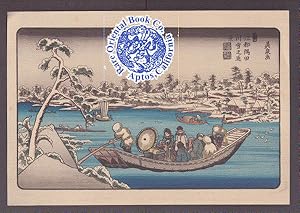

![Bild des Verkäufers für [Weapon, Education] Samurai and martial arts, published ca. 1850 zum Verkauf von Antiquariaat Arine van der Steur / ILAB](https://pictures.abebooks.com/inventory/md/md31824902445.jpg)
![Bild des Verkäufers für TWO COLOR WOODBLOCK PRINTED SHUNGA [EROTIC] SHEETS. zum Verkauf von RARE ORIENTAL BOOK CO., ABAA, ILAB](https://pictures.abebooks.com/inventory/md/md22514607884.jpg)
![Bild des Verkäufers für Edo Nihonbashi yori Fuji o miru zu]. [A View of Mt. Fuji from Nihonbashi]. zum Verkauf von Asia Bookroom ANZAAB/ILAB](https://pictures.abebooks.com/inventory/md/md31767195085.jpg)
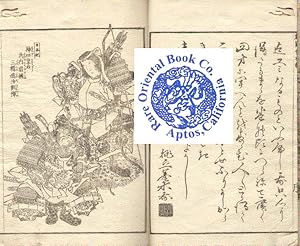
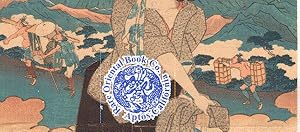
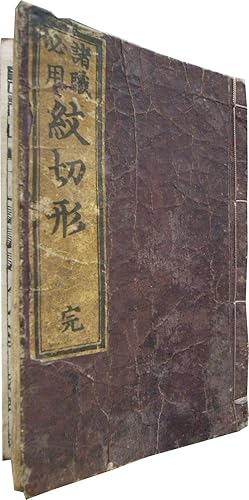
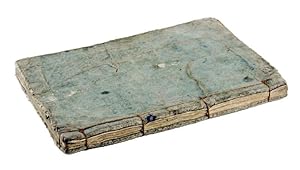
![Bild des Verkäufers für Keisai Eisen: Sashi-e Hangi [An Original Woodblock Carved with an Illustration by Master Ukiyo-e Painter Keisai Eisen] zum Verkauf von Kagerou Bunko (ABAJ, ILAB)](https://pictures.abebooks.com/inventory/md/md30773484007.jpg)